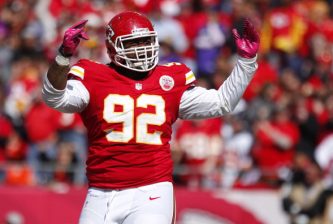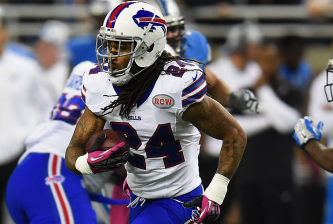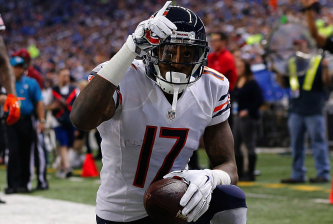The term “franchise quarterback” is tossed around often, even more often than the word “elite” to describe those quarterbacks. By definition, the franchise quarterback is a cornerstone, one that provides a sense of security. Once this elusive gem is found, a general manager is much more at ease. His life mission is complete, because he now has a long-term answer at the most important offensive position.
But history — both recent, and further back — shows there will be at least one significant stretch (often a full season) when that cigar-puffing comfort is interrupted.
Last year 51 starting quarterbacks were used. That included Aaron Rodgers, he of the franchise quarterback label himself, going down for nearly half the season. Robert Griffin III didn’t miss any time due to his severe knee injury sustained the previous January, but he had to rush back and wasn’t himself.
Already this year there are multiple dents at the position. Sam Bradford isn’t on the franchise QB level, but he was still an answer for at least one more season, and now he’s gone. Cam Newton’s rib injury doesn’t sound serious enough to keep him out once games matter, but it’s not exactly a good look when a mobile quarterback has to recover from two injuries in one offseason.
Back to that history. If we make the pretty safe assumption that Tom Brady, Drew Brees, and Peyton Manning will be in the hall of fame five years after they retire, and then also look back at the last seven quarterbacks to have replicas of their heads in Canton, the importance of their backups is glaring. At least a full season is often missed, either all at once or over the course of a career.
Quickly after a snap or rip, that franchise quarterback tag means little, as Brett Favre ironman streaks are exceedingly rare (seriously, the old man missed three starts over 19 years). Let’s take a trip down that road of hurt, and see how fast quarterback comfort can vanish.
In brackets is the amount of games each quarterback appeared in since his first start, compared to the number he could have started if fully healthy.
Tom Brady (started 192 of a possible 207 games, 92.8 percent)
Tom Brady has logged 11 fully healthy seasons since taking over for Drew Bledsoe in 2001. But thrown in there is nearly a full season on the mend when he tore his ACL in Week 1 of 2008, missing 15 games.
Drew Brees (started 186 of a possible 192 games, 96.9 percent)
Drew Brees isn’t just lucky that he didn’t miss any time when he demolished his shoulder in such a creatively horrible way. He’s lucky his career didn’t end.
Brees didn’t suffer your typical, ho-hum dislocated shoulder on that late-season play in 2005. No, he had a 360-degree labrum tear, making teams a wee bit jittery about signing him.
You know the rest: the Saints took a chance, the Dolphins hilariously didn’t, and Brees has gone on to do a lot of passing, smash records, take names, and win a championship. So it’s easy to forget that long before his prime, Brees’ career was in jeopardy, with doctors saying he had a 25 percent chance of a full recovery.
Peyton Manning (started 240 of a possible 256 games, 93.8 percent)
Arguably(?) the best quarterback of this generation was lost for a full season too. Worse, Manning’s injury went beyond just being career threatening. For a time, his quality of life was uncertain.
Major and multiple neck injuries nearly derailed his career when he wasn’t exactly a young guy anymore. In his mid 30s Manning went under the knife four times, the most significant of which was spinal fusion surgery. He had to miss a full season in 2011, and to the surprise of no one the Colts plummeted, and were faced with a decision that was difficult, though the right direction was still clear. They had to take Andrew Luck with the first overall pick and move on from Manning. The franchise legend was incredibly fragile at the time, and there was fear he would implode after a mere touch from a defender.
But even though he may belong in a bubble and not under center, Manning still hasn’t missed a single start through two years in Denver.
John Elway (started 229 of a possible 256 games, 89.5 percent)
This man isn’t normal. No really, he isn’t, because in high school John Elway tore his ACL, and high school happened in 1978 for him. That was when torn ACLs were still career-crushing injuries, with doctors shrugging and going back to whatever they were smoking in the office.
In 1985 he had microscopic surgery on his knee, only three years into his career. It’s an injury that gradually worsened, with his knee deteriorating to the point that a steady, wild west cowboy gimp was always part of the Elway image. Yet since his soul is filled with the spirit of a raging bull, Elway still played 16 seasons, missing more than four games in a year only once.
Dan Marino (240 of a possible 270 games, 88.9 percent)
Marino tore his Achilles in 1993, at the age of 32. Rips of that kind are never fun, but if it were possible to play god and schedule horrible life events at a convenient time, you’d slot this one in much earlier.
At that age Marino had already absorbed the typical hammering any quarterback endures over 10 seasons, and he had done it while staying healthy, playing the full 16 games in eight of those first years. Then suddenly he crumbled, and there was fear a more elderly quarterback wouldn’t be able to recover quite the same as a younger model.
So here we have another case of tears when a team that had a cornerstone quarterback lost him for nearly a full season, and one of his prime years was wasted.
Warren Moon (started 192 of a possible 240, 80 percent)
Warren Moon took our standard definition of “ironman” and spat on it. He didn’t take his first snap in the NFL until the age of 28, after spending five years in the CFL. Then because he can’t identify with what normal mortals refer to as “pain”, he still started 10 games for the Seahawks at the age of 42, and two years later made a spot start for the Chiefs. At 44.
He still had the standard bruising and such, but Moon endured and kept throwing. His most significant injury was a broken collarbone in 1996, when he missed half the season.
Joe Montana (Started 164 of a possible 217, 74.6 percent)
When you look at the hurt football put on Joe Montana, it quickly becomes remarkable that he was able to keep playing until the age of 38, and do it at a high level.
His Moon-like status as someone who laughs heartily at pain started in 1986. That’s when Montana had surgery to repair a ruptured disk in his back. The surgery occurred in September, and it was said to be career threatening. Then 56 days later he was the 49ers’ starting quarterback again.
But although he powered through, both that year and the nearly two full seasons he missed much later on due to an arm injury (1991, and all but one game in 1992) make Montana another example of a franchise quarterback vanishing.
Steve Young (started 104 of a possible 128 games, from 1992 to 1999, 81.3 percent)
Steve Young didn’t become a full-time starter until 1991 at the age of 30, when his play eventually pushed Montana out of San Francisco. Since he had stayed so fresh and he didn’t have to absorb the typical NFL pounding until far later in his career than most quarterbacks, it would have easily been possible for Young to play into his 40s.
Then concussions happened. A lot of them, all at once.
Young still can’t remember how many concussions he sustained, saying as much during an interview last year. The safe estimate is seven during his NFL career, and at least one more prior to that at BYU.
Or at least those are the reported concussions. His shortened career and repeated head injuries have been at the forefront of the concussion conversation over the past few years, including a column by Young’s mom last fall.
Jim Kelly (started 160 of a possible 174 games, 92 percent)
Jim Kelly stayed pretty healthy over his 11 seasons in Buffalo, never missing more than three games in a season while becoming the first quarterback to lead his team to four straight Super Bowl appearances.
Still, the cumulative effect of even the most minor ding adds up to nearly a full season of missed games for Kelly over his career.
Troy Aikman (started 165 of a possible 191 games, 86.4 percent)
This is a downright frightening story from League of Denial, the PBS documentary that cast light on the concussion darkness the NFL has been willfully living in for some time. For Troy Aikman, there was quite literal darkness following the 1994 NFC Championship game.
Though he also missed time due to a broken collarbone in 1998 (five games), those devastating hits to the head led to an early end for Aikman. He retired at the age of 34, when he still had prime years left.
LaVar Arrington had other ideas.




